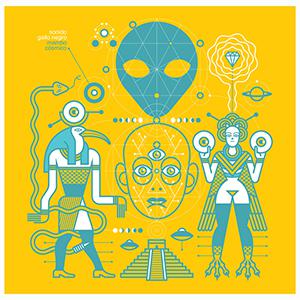The Mexican black rooster has crowed again and that resulted in 'Mambo Cosmico'. If for their previous albums, the members Sonido Gallo Negro still drew on Latin and Central American mythologies for inspiration, for 'Mambo Cosmico' they ventured across the ocean to build a cosmic bridge to the gods of ancient Egypt and Mesopotamia (the image of Thoth, Egyptian god of the Moon, magic, the calendar, the art of writing and wisdom, on the cover of 'Mambo Cosmico', song titles like 'Mambo Egipcio' and 'Cumbia Ishtar', a reference to Inanna or Ishtar, the Mesopotamian goddess of fertility, love, war and sex). The cumbia sonidera, huayno, boogaloo and chicha of 'Sendero Mistico' is supplemented with genres like mambo, cha-cha-cha, porro and danzon, of course all given the bands signature psychedelic treatment. The track list of 'Mambo Cosmio' contains 9 original compositions and two covers: 'Tolu', a 1950s porro by Colombian composer Lucho Bermudez, and '¿Quien Sera?', a Mexican mamby composed by band leader Pablo Beltran Ruiz. The rousing 'La Danza De Los Diablos' is dedicated to Gaspar Yanga, the African leader of the 1570 slave rebellion in the area of Córdoba and Orizaba in Central Veracruz, Mexico. Moreover, it's not the only reference to Veracruz on the album, as 'Catemaco', a Mexican cumbia, is an ode to the lake town known as a gathering place for witches, sorcerers and shamans, practicing all sorts of holistic medicine. 'La Foca Cha Cha' is a tribute to the Mexican king of mambo, Pérez Prado, nicknamed cara é foca (loosely translated: "seal face"). 'Danzon Fayuquero', a song dedicated to: "...todos los fayuqueros de Tepito..." deserves some explanation. The term fayuquero can be translated as "smuggler", and Tepito, Mexico-City's contraband barrio, is right next to cha-cha-cha, mambo and danzon temple Salon Los Angeles. With 'Mambo Cosmico', Sonido Gallo Negro once again delivers an extremely intriguing trippy album.


